Homemade Clay Pot Gada Mace
These are instructions for making a homemade Clay Pot Gada Mace in the ancient and traditional way used in Indian wrestlers akharas (gyms). The process is quite simple and easy to follow and can be made cheaply by anyone wanting to train with one of the oldest pieces of training equipment around.
Ingredients
From the left, Kwikset Concrete, Trowel, Scissors, Cable Ties, Clay Pot (Ceramic Pot) or Large Plastic Container, Bamboo Pole (diameter 1″/1.25″ or 2.5/3 cms), Steel Rods (3/8″ or 1cm), Bucket of Water, Cup, Stirring Stick, the following are not shown, Empty Bucket (to mix concrete), Breathing Mask, Vinyl or Plastic Gloves, Safety Glasses, Hammer, Sand Paper and Tape Measure.
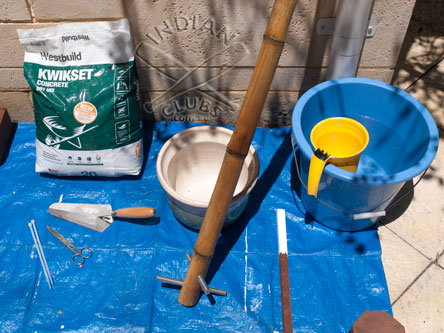
Bamboo with Two Holes drilled at Right Angles
This is a close-up view of the bamboo with two holes drilled at right angles, the holes should be at least 2″ or 5cms apart.
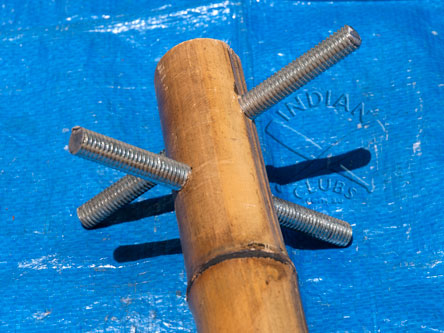
The holes will house the Steel Rods and need to be a tight fit, the Steel Rods in the photograph are threaded, drilling a slightly smaller hole ensured that the Steel Rods fitted tightly to stop them moving when the bamboo pole is pushed into the wet concrete.
Clay Pot (Ceramic Pot) Mold
A visit to the local garden centre, tape measure in hand, should provide a selection of pottery suitable to act as a mold for the homemade Clay Pot Gada Mace. Choose something cheap and cheerful, remember that you will be smashing the Clay Pot.
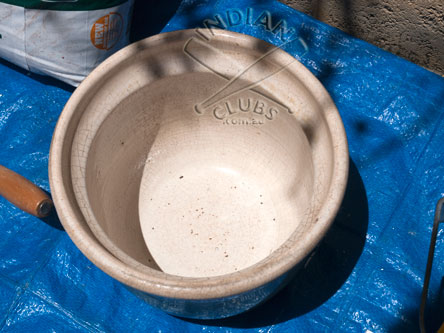
Starting with the dimensions INSIDE the pot, 8″ wide x 6″ deep imperial or 20cms wide x 15cms deep metric, should produce a Gada Mace head weighing approximately 20lbs to 22lbs, or 9kgs to 10kgs. Try to find a pot that has a flat bottom inside of the bowl, this will mean that the Gada Mace will be able to stand upright.
Plastic Whey Container Mold
Make a homemade Clay Pot Gada Mace suitable for indoor use that will not damage floor coverings in a gym. The idea is to leave the plastic container mold in place once the concrete has set. The plastic container will form a protective shell around the concrete which will protect your gym floor.
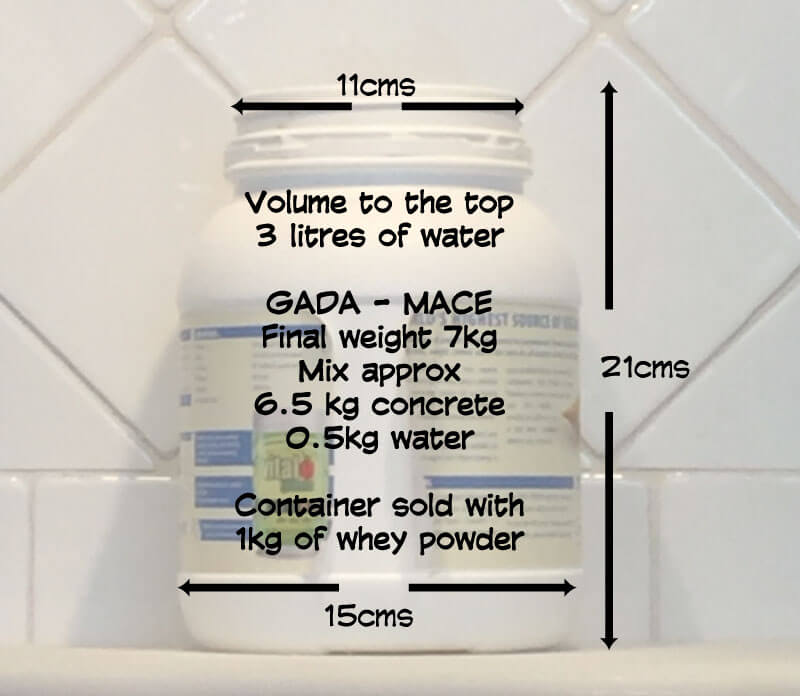
You MUST allow more curing time for the concrete, I suggest twice as much as stated on the packaging. Don’t forget the get all the air pockets out whilst the concrete is wet. The measurements in the picture below will make you a 7kg or 15lb Gada (mace), use it as a guideline for size.
The William Calvani Mold
William Calvani makes his homemade Clay Pot Gada Mace using a plastic sphere which he cut in half to create a mold. One hemisphere has a hole cut into its top to enable the concrete to be poured in. The two hemispheres are joined with duct tape. The concrete is loaded and the handle set into position. Once the concrete is dry the duct tape and mold are removed.

 |
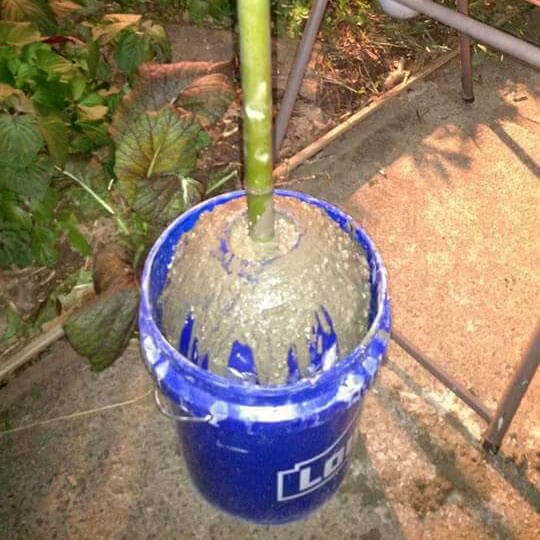 |
Final Fit Test
Make sure that the Bamboo Pole with the steel rods firmly positioned, will fit through the opening of the Clay Pot.

Just as a reminder you will be using Kwikset Concrete and you do not want to discover that something is wrong at that stage.
Mix the Kwikset Concrete
Let say for example that you want to make a homemade Clay Pot Gada Mace that weighs 10kg. Put on a Breathing Mask and Vinyl Gloves. Make up the concrete and water mix to the right consistency in a plastic bowl or bucket.
Make sure that everything is well mixed. Next, weigh the bucket and adjust the contents by adding or removing the concrete mix to the required weight, eg.10kg. or the weight of your choice. Lead or steel shot can be added to increase the desired weight.
Do not trap air inside the Clay Pot
When you have finished weighing, you are ready to fill the Clay Pot, make sure that you do not trap air inside the Clay Pot, it is better to transfer the concrete in small amounts, to avoid air pockets. Use a trowel, go around the wet concrete, by pushing the trowel into the concrete to release any trapped air.
Warning
Failure to avoid air pockets can result in the mace head weakening and possibly splitting open.
Position the Bamboo and Steel Rod handle
Time is limited as you are using Kwikset Concrete. Take the prepared handle and push it firmly into the mixed concrete, slightly twisting it as it sinks into the Clay Pot.
Secure the Bamboo Handle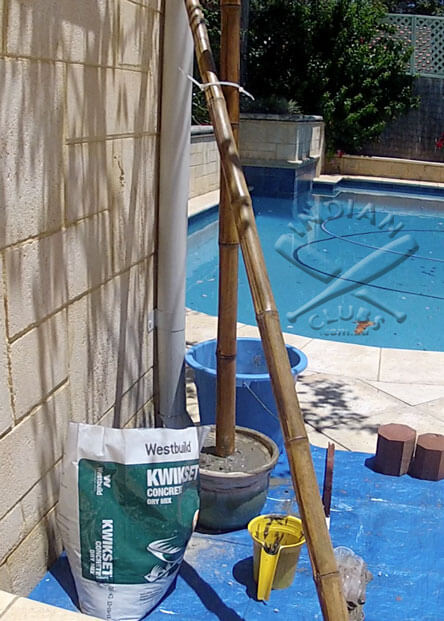
As the concrete is still soft, you need to secure the Bamboo Handle whilst the concrete dries. This photograph shows two cable ties securing the handle to a spare pole leaning against a wall.
Drying and Curing time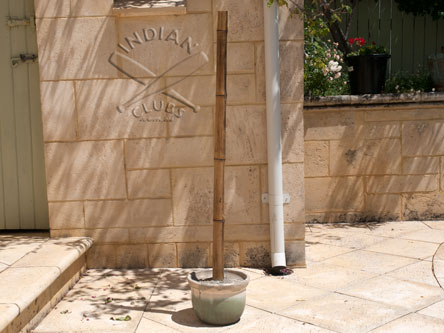
Your new home made Clay Pot Gada Mace is taking shape, and now you have to let the concrete dry and cure, read the information on the concrete packaging to make sure that you allow the appropriate time. This will take a lot longer in colder climates, the illustrated Gada mace dried for 48 hours.
Tip from Nathan Baxter, Western Australia
A little trick I learned from years of making Atlas Stones. First, soak the terracotta pot overnight. Once you pour the cement, wrap everything in a damp towel and keep it wet for a few days. Once out of the pot, keep the mace head wrapped in a wet towel for the first few days.
Sacrifice the Clay Pot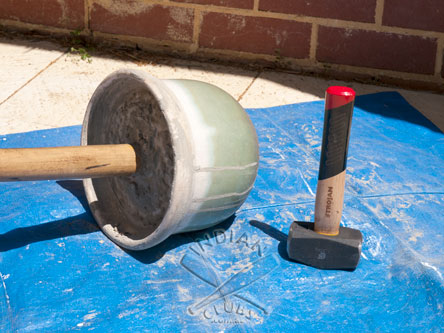
The fully dried Homemade Clay Pot Gada Mace is now ready for the highlight event. The sacrificial smashing of the Clay Pot. Put on your Safety Glasses and get the Hammer.
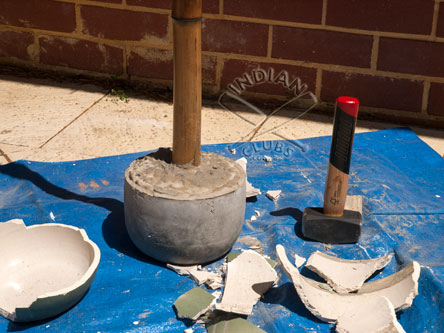
Lay the homemade Clay Pot Gada Mace on the side and carefully hit the Clay Pot, it will offer no resistance, very satisfying nonetheless.
More Drying time
With the Clay Pot gone into oblivion, the Gada Mace head needs more drying time, check your instructions on the Kwikset Concrete packaging.
Paint your Gada Mace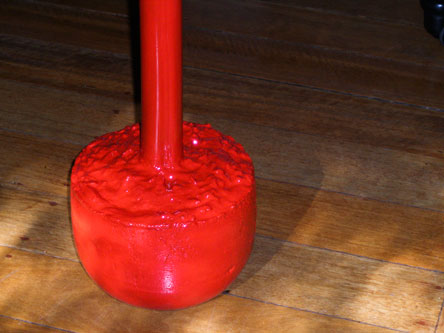
Any concrete has a sandy residue that can be easily sealed with paint. A white undercoat, followed by a couple of applications of your favourite colour. Finally cut the handle to your preferred length, if you are not sure, a good starting length is 4’6″ or 140 cms. This measurement is from tip to toe, the full length including the head and handle. Rub the handle lightly with Sand Paper to remove any splintering of the bamboo, apply a clear varnish to finish.

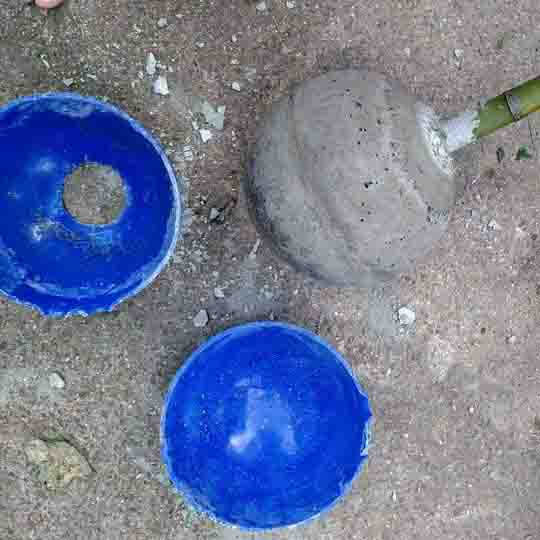
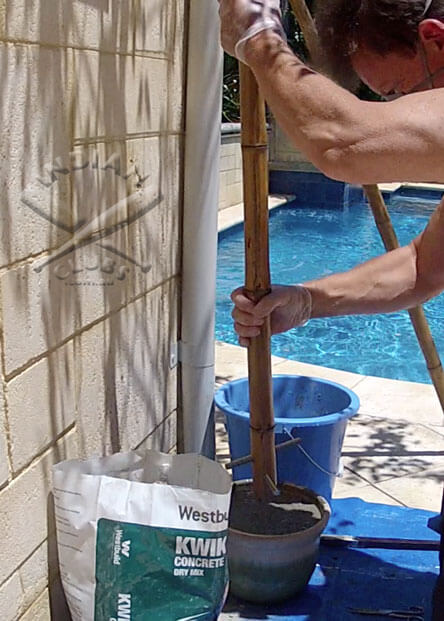
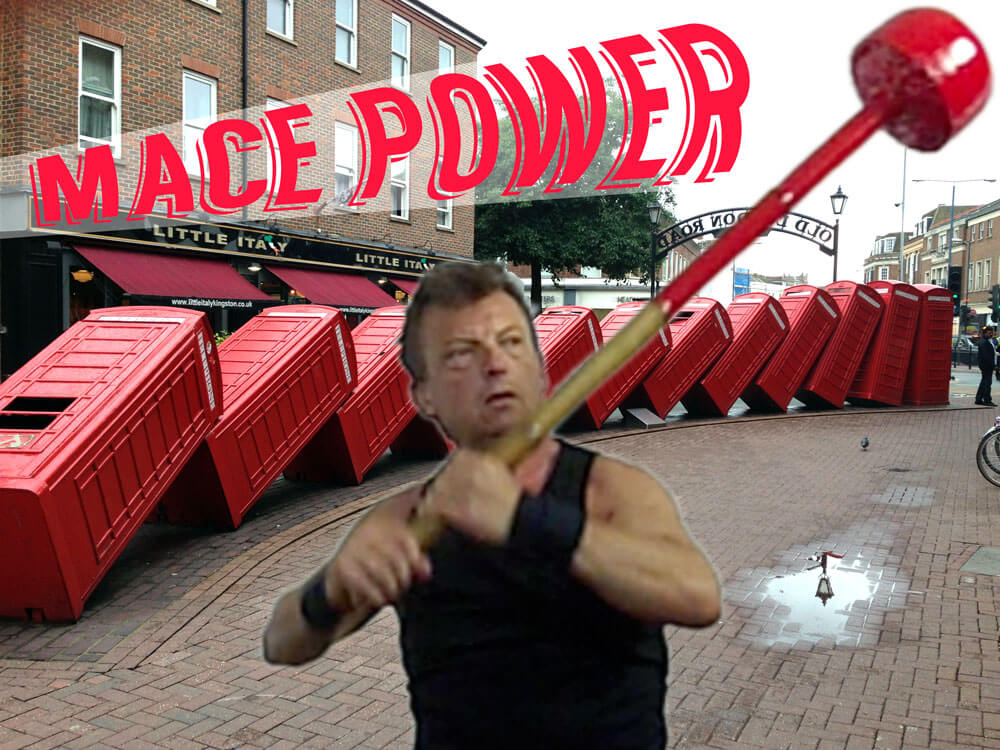

I look forward to making a traditional Indian Gada like this. I bought some bamboo from a local bamboo farm and I am rearing to go.
Before I found this article, I made a mace with a discarded water tank buoy and a steel pipe, it came out to be about 7.4 kilos (15 pounds). It looks just like the William Calvani mold but I did not separate the buoy so now I have an orange ball on one end. I personally like the way it looks.
I love cheap practical things. The mace is a great exercise and it is incredibly cheap to create. The buoy I used was discarded by the store because it was defective (free). I had a smidge of quick drying concrete sitting around for so many years (kinda free now. New it would be under $10). The pipe was a few bucks.
Now I want to make so many more.
It’s great to hear that you make and swing your own Gada Mace. I started to make my own following my first visit to Varanasi in India. I have 6kg, 7kg, 8kg, 9kg, 10kg, 12kg and 15kg which allows me to ladder through the weights. Also, the lighter ones are great for one arm swings. Keep at it. Best Regards. Paul
My gada cracks in the middle. Do you know why?
Hi Luis,There are a few reasons why the gada head will crack.
The gada head will crack if:
You used a wrong ratio of concrete and water.
Air pockets are trapped inside the head, which you need to remove while the concrete is wet and before it dries.
You swung the gada before it was dry.
You dropped it on a hard surface, like concrete, for example.